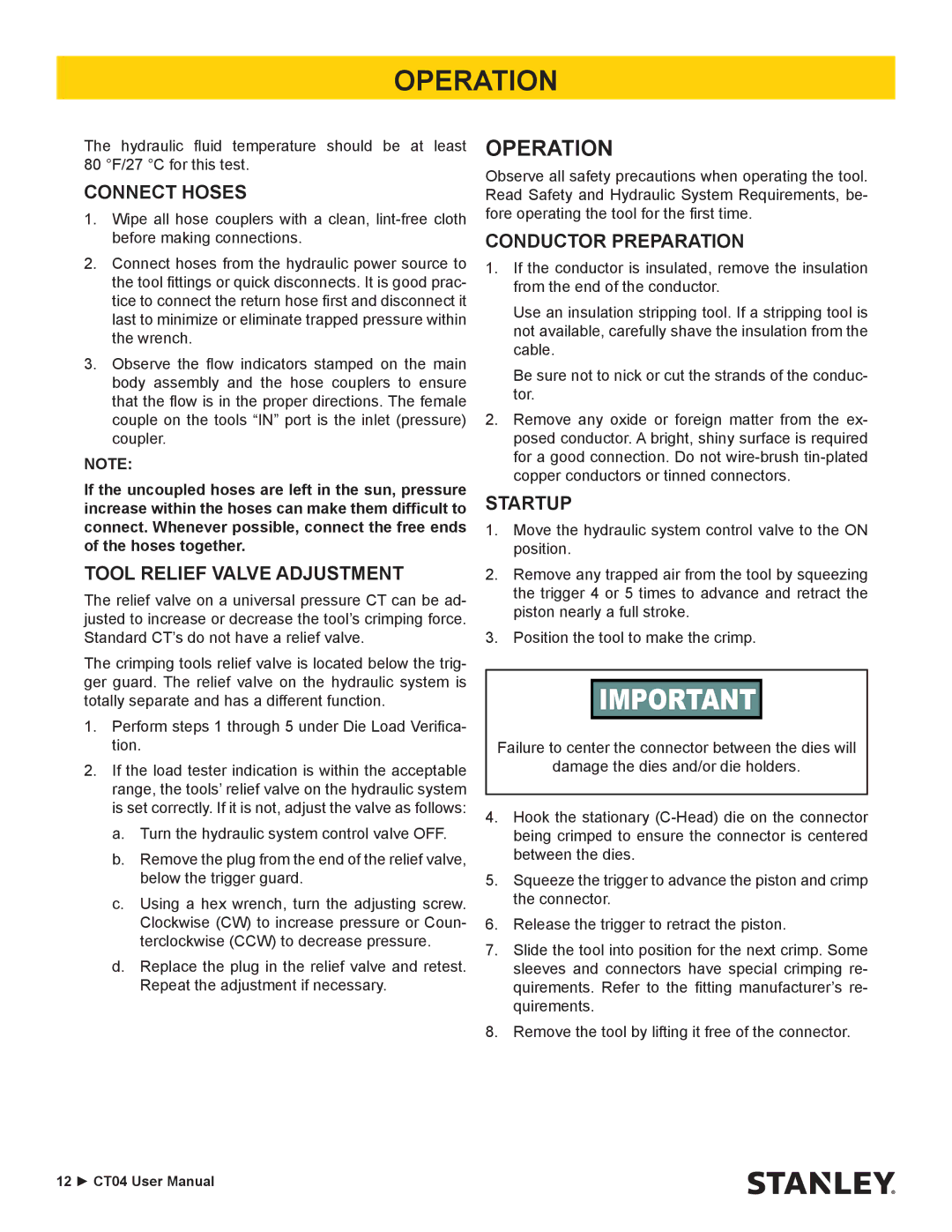
OPERATION
The hydraulic fluid temperature should be at least 80 °F/27 °C for this test.
CONNECT HOSES
1.Wipe all hose couplers with a clean,
2.Connect hoses from the hydraulic power source to the tool fittings or quick disconnects. It is good prac- tice to connect the return hose first and disconnect it last to minimize or eliminate trapped pressure within the wrench.
3.Observe the flow indicators stamped on the main body assembly and the hose couplers to ensure that the flow is in the proper directions. The female couple on the tools “IN” port is the inlet (pressure) coupler.
NOTE:
If the uncoupled hoses are left in the sun, pressure increase within the hoses can make them difficult to connect. Whenever possible, connect the free ends of the hoses together.
TOOL RELIEF VALVE ADJUSTMENT
The relief valve on a universal pressure CT can be ad- justed to increase or decrease the tool’s crimping force. Standard CT’s do not have a relief valve.
The crimping tools relief valve is located below the trig- ger guard. The relief valve on the hydraulic system is totally separate and has a different function.
1.Perform steps 1 through 5 under Die Load Verifica- tion.
2.If the load tester indication is within the acceptable range, the tools’ relief valve on the hydraulic system is set correctly. If it is not, adjust the valve as follows:
a.Turn the hydraulic system control valve OFF.
b.Remove the plug from the end of the relief valve, below the trigger guard.
c.Using a hex wrench, turn the adjusting screw.
Clockwise (CW) to increase pressure or Coun- terclockwise (CCW) to decrease pressure.
d.Replace the plug in the relief valve and retest. Repeat the adjustment if necessary.
OPERATION
Observe all safety precautions when operating the tool. Read Safety and Hydraulic System Requirements, be- fore operating the tool for the first time.
CONDUCTOR PREPARATION
1.If the conductor is insulated, remove the insulation from the end of the conductor.
Use an insulation stripping tool. If a stripping tool is not available, carefully shave the insulation from the cable.
Be sure not to nick or cut the strands of the conduc- tor.
2.Remove any oxide or foreign matter from the ex- posed conductor. A bright, shiny surface is required for a good connection. Do not
STARTUP
1.Move the hydraulic system control valve to the ON position.
2.Remove any trapped air from the tool by squeezing the trigger 4 or 5 times to advance and retract the piston nearly a full stroke.
3.Position the tool to make the crimp.
IMPORTANT
Failure to center the connector between the dies will
damage the dies and/or die holders.
4.Hook the stationary
5.Squeeze the trigger to advance the piston and crimp the connector.
6.Release the trigger to retract the piston.
7.Slide the tool into position for the next crimp. Some sleeves and connectors have special crimping re- quirements. Refer to the fitting manufacturer’s re- quirements.
8.Remove the tool by lifting it free of the connector.
12 ► CT04 User Manual
